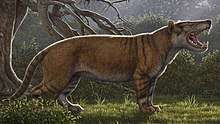Simbakubwa
Simbakubwa kutokaafrika ("great lion from Africa") is an extinct species of mammal of the family Hyainailouridae in the order Hyaenodonta. It lived during the early Miocene of Kenya. The type specimen was recovered from deposits dated to be 23 million years old. Possibly reaching up to 1,500 kg (3,300 lb), it might have surpassed the modern polar bear in size.[1]
| Simbakubwa | |
|---|---|
 | |
| artist's restoration | |
| Scientific classification | |
| Kingdom: | |
| Phylum: | |
| Class: | |
| Order: | |
| Family: | |
| Genus: | Simbakubwa |
| Binomial name | |
| Simbakubwa kutokaafrika Borths, Stevens, 2019 | |
Description
The fossils of Simbakubwa were first discovered by rural Kenyans at Meswa Bridge, Western Kenya thereafter Matthew Borths and Nancy Stevens published the findings after examining the fossils which had been stored at the Nairobi National Museum in Kenya for decades.[2] The type specimen consists of a mandible from the lower jaw, a right upper maxilla and some postcranial remains. The light wear patterns on the dentition indicate that the holotype specimen was a young adult at the time of its death. The study of the postcranial remains indicates Simbakubwa was possessed of a semi-digitigrade walking stance.[1]
Paleoecology
Simbakubwa, like other hyainailourids, probably was a specialist hunter and scavenger that preyed on creatures such as rhinoceroses and early proboscideans. It may have been somewhat less specialized in crushing bone than its later relatives such as Hyainailouros. However, like Hyainailouros, Simbakubwa possessed lingually rotating carnassial blades, ensuring a constant shearing edge throughout its life.[1]
References
- Borths, M. R.; Stevens, N. J. (2019). "Simbakubwa kutokaafrika, gen. et sp. nov. (Hyainailourinae, Hyaenodonta, 'Creodonta,' Mammalia), a gigantic carnivore from the earliest Miocene of Kenya". Journal of Vertebrate Paleontology. 39: e1570222. doi:10.1080/02724634.2019.1570222.
- Zuckerman, C. (18 April 2019). "This new species of ancient carnivore was bigger than a polar bear". National Geographic. Retrieved 2019-04-18.